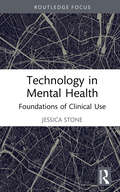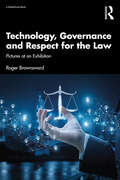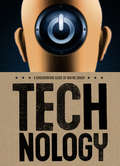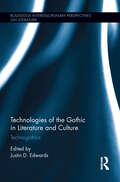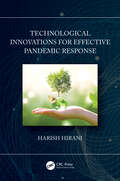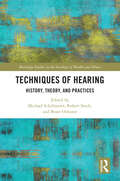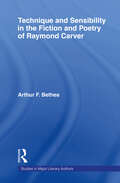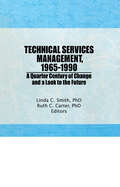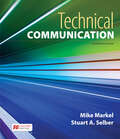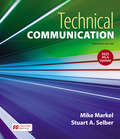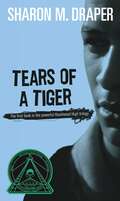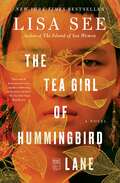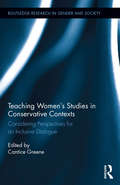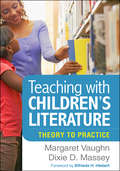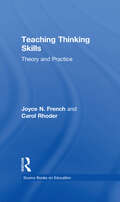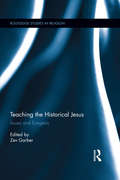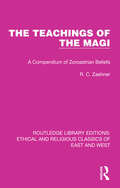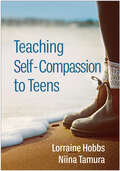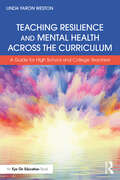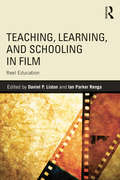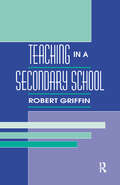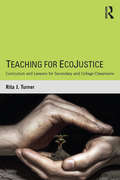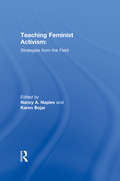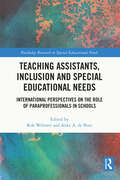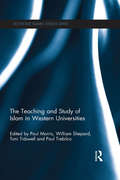Special Collections
Benetech’s Global Certified Accessible Titles
Description: Benetech’s GCA program is the first independent third-party EPUB certification to verify ebook accessibility. By creating content that is born accessible, publishers can meet the needs of all readers. Learn more: https://bornaccessible.benetech.org/
- Table View
- List View
Technology in Mental Health
by Jessica StoneTechnology in Mental Health focuses on the responsible integration of technology into therapy in a world affected by COVID. Author Jessica Stone discusses the pandemic’s effects on the mental health field, historical fundamentals, and possible future implications. Chapters also explore legal and ethical considerations as well as educational and supervision needs. Seasoned and new clinicians alike will find valuable information in these pages as they progress from traditional to modern to post-COVID mental health treatment.
Technology, Governance and Respect for the Law
by Roger BrownswordIn the context of the technological disruption of law and, in particular, the prospect of governance by machines, this book reconsiders the demand that we should respect the law, simply because it is the law. What does ‘the law’ need to look like to justify our respect? Responding to this question, the book takes the form of a dialectic between, on the one side, the promise of the prospectus for law and, on the other, the discontent provoked by the performance of law in practice; this is followed by a synthesis. Four pictures of law are considered: two are traditional pictures – law as order and law as just order; and two are prompted by the technological disruption of law – law as governance by machines and law as self-governance by humans. These pictures are tested in five performance areas: contract law, criminal law, biolaw, information law, and constitutional law. The synthesis, revealing the complexity of the demand for respect, highlights three particular points. First, the only prospectus for law that clearly commands respect is one that is committed to protecting the global commons (the preconditions for humans to form their own communities with their own forms of governance); second, any form of governance by humans will invite reservations and push-back against the demand for respect; and, third, governance by machines is not so much a superior form of governance as a radically different form in which questions about respect are redundant. This book will appeal to scholars and students with interests in the broad and burgeoning field of law, regulation and technology, as well as to legal theorists, practitioners, and others interested in the impact of new technology on law.
Technology
by Wayne GradyA sweeping history of technology’s advance that raises the crucial question of whether we are in control of technology, or whether technology controls us. An excellent introduction to technology for young adults.There is no doubt that we have come to rely on technology, not only for our comfort and convenience, but for our very survival as a species. A hundred and fifty years ago, Charles Darwin noted wryly that if the human species were returned to the wild without the advantage of technology, we would become extinct in six weeks.Since that time, technology has proliferated to the extent that we can no longer conceive of life without it. As this book shows, technology is more than the sum of the tools we use, whether they are primitive ploughs or space shuttles. It is a way of seeing the world, the way we determine how the world works -- technology is a way of thinking.We see this in the way technology has invaded our language: we speak of the education system, the cultural industry. Since the 18th century, we have tended to describe the universe as a giant clockwork, the body as a machine, and, more recently, the mind as a computer. These are all aspects of the degree to which we have come to live in a technological age."[The Groundwork Guides] are excellent books, mandatory for school libraries and the increasing body of young people prepared to take ownership of the situations and problems previous generations have left them." — Globe and Mail
Technologies of the Gothic in Literature and Culture
by Justin D. EdwardsThis volume, a collection with contributions from some of the major scholars of the Gothic in literature and culture, reflects on how recent Gothic studies have foregrounded a plethora of technologies associated with Gothic literary and cultural production. The engaging essays look into the links between technologies and the proliferation of the Gothic seen in an excess of Gothic texts and tropes: Frankensteinesque experiments, the manufacture of synthetic (true?) blood, Moreauesque hybrids, the power of the Borg, Dr Jekyll’s chemical experimentations, the machinery of Steampunk, or the corporeal modifications of Edward Scissorhands. Further, they explore how techno-science has contributed to the proliferation of the Gothic: Gothic in social media, digital technologies, the on-line gaming and virtual Goth/ic communities, the special effects of Gothic-horror cinema. Contributors address how Gothic technologies have, in a general sense, produced and perpetuated ideologies and influenced the politics of cultural practice, asking significant questions: How has the technology of the Gothic contributed to the writing of self and other? How have Gothic technologies been gendered, sexualized, encrypted, coded or de-coded? How has the Gothic manifested itself in new technologies across diverse geographical locations? This volume explores how Gothic technologies textualize identities and construct communities within a complex network of power relations in local, national, transnational, and global contexts. It will be of interest to scholars of the literary Gothic, extending beyond to include fascinating interventions into the areas of cultural studies, popular culture, science fiction, film, and TV.
Technological Innovations for Effective Pandemic Response
by Harish HiraniThis reference text discusses the potential of efficient R&D management during times of pandemic crisis and how it can provide time-bound real-life deliverables to ward-off the contamination-linked vulnerability aspects of social interaction. It discusses important topics including mechanical ventilator with oxygen enrichment, hospital waste management facility, hospital care assistive robotic devices, implementation of smart manufacturing, special purpose machines, micro machining, 3D printing, disposal of plastic waste utilizing high temperature plasma, automatic biomass briquetting plant, and fully automatic biodiesel plant. Features: Discusses novel technological innovations developed especially to effectively counter pandemics such as COVID 19. Explores how R&D modelling of technology can be interspersed with socio-economic values. Covers how innovative technological solutions can be developed as per the situational requisites and deployed in the least possible time to make maximum impact. Discusses industrial manufacturing and automation techniques. The text will be useful for graduate students, and academic researchers working in diverse areas such as mechanical engineering, industrial engineering, production engineering, manufacturing science, and automobile engineering. It covers influences of Pandemics on water and sanitation services, floating capsule-based biofilm reactor (FCBBR) methodology, and innovative segregation of waste through a mechanized model.
Techniques of Hearing
by Michael Schillmeier, Robert Stock, and Beate OchsnerHearing, health and technologies are entangled in multi-faceted ways. The edited volume addresses this complex relationship by arguing that modern hearing was and is increasingly linked to and mediated by technological innovations. By providing a set of original interdisciplinary investigations that sheds new light on the history, theory and practices of hearing techniques, it is able to explore the heterogeneous entanglements of sound, hearing practices, technologies and health issues. As the first book to bring together historians, scholars from media studies, social sciences, cultural studies, acoustics and neuroscientists, the volume discusses modern technologies and their decisive impact on how ‘normal’ hearing, enhanced and smart hearing as well as hearing impairment have been configured. It brings both new insights into the histories of hearing technologies as well as allowing us to better understand how enabling hearing technologies have currently been unfolding an increasingly hybrid ecology engaging smart hearing devices and offering stress-free hearing and acoustic wellbeing in novel auditory environments. The volume will be of interest to all scholars and students of disability studies, sound studies, sociology of health and illness, medical history, health and society as well as those interested in the practices and techniques of self-monitored and smart hearing.
Technique and Sensibility in the Fiction and Poetry of Raymond Carver
by Arthur F. BetheaA comprehensive examination of the fiction and poetry of Raymond Carver.
Technical Services Management, 1965-1990
by Ruth C Carter and Linda C SmithGain an in-depth understanding of changes in technical services that have taken place over a quarter century and look at future trends and changes that may occur. Technical Services Management surveys and analyzes technical services in libraries from 1965 to 1990, a formative period and one of great change in library operations. The book also identifies trends that continue to impact technical services operations in libraries today. Readers gain a comprehensive knowledge of where the field has been and where it is now to help them plan and prepare more effectively for the future.Most chapters are historical, combined with a firm grasp of the present and a glimpse or more at the future. They are grouped to reflect the various aspects of technical services. Trends in technical services are considered in chapters on the development of technical services literature and the major changes in technical services in school libraries. Chapters on the major subdivisions within technical services--acquisitions and collection development, cataloging, and preservation--trace changes in library operations and the impact of automation. Issues in catalog design are explored in chapters on the emergence of online public access catalogs, bibliographic utilities, and approaches to authority control. Efforts to improve subject access are addressed through chapters on subject cataloging, the Dewey Decimal Classification, and indexing in the U.S. and Great Britain. To keep pace with changes in technical services, changes in professional education and development are needed as documented in chapters on cataloging education, continuing education in technical services, and the role of professional organizations. The final chapter outlines new challenges in the future and new roles for librarians in an electronic environment.Effective planning for the future includes learning about the past. Technical Services Management, 1965--1990 is a vital resource for library historians, library educators, technical services librarians, and graduate students in library and information science who need to know “how things were” in order to see more clearly “how things will be.”
Technical Communication
by Stuart A. Selber and Mike MarkelMake the leap from writing in college to writing in a variety of workplace settings and contexts with Technical Communication. Practical advice and real-world examples let you practice with the kinds of writing processes and products you’ll encounter on the job.
Technical Communication
by Stuart A. Selber and Mike MarkelThis ebook has been updated to provide you with the latest guidance on documenting sources in MLA style and follows the guidelines set forth in the MLA Handbook, 9th edition (April 2021).Make the leap from writing in college to writing in a variety of workplace settings and contexts with Technical Communication. Practical advice and real-world examples let you practice with the kinds of writing processes and products you’ll encounter on the job.
Tears of a Tiger
by Sharon M. DraperIn one horrifying night, Andy's life changed forever... Andy Jackson was driving the car that crashed one night after a game, killing Robert Washington, his best friend and the captain of the Hazelwood High Tigers. It was late, and they'd been drinking, and now, months later, Andy can't stop blaming himself. As he turns away from family, friends, and even his girlfriend, he finds he's losing the most precious thing of all -- his ability to face the future.
The Tea Girl of Hummingbird Lane
by Lisa SeeFrom #1 New York Times bestselling author Lisa See, &“one of those special writers capable of delivering both poetry and plot&” (The New York Times Book Review), a moving novel about tradition, tea farming, and the bonds between mothers and daughters.In their remote mountain village, Li-yan and her family align their lives around the seasons and the farming of tea. For the Akha people, ensconced in ritual and routine, life goes on as it has for generations—until a stranger appears at the village gate in a jeep, the first automobile any of the villagers has ever seen. The stranger&’s arrival marks the first entrance of the modern world in the lives of the Akha people. Slowly, Li-yan, one of the few educated girls on her mountain, begins to reject the customs that shaped her early life. When she has a baby out of wedlock—conceived with a man her parents consider a poor choice—she rejects the tradition that would compel her to give the child over to be killed, and instead leaves her, wrapped in a blanket with a tea cake tucked in its folds, near an orphanage in a nearby city. As Li-yan comes into herself, leaving her insular village for an education, a business, and city life, her daughter, Haley, is raised in California by loving adoptive parents. Despite her privileged childhood, Haley wonders about her origins. Across the ocean Li-yan longs for her lost daughter. Over the course of years, each searches for meaning in the study of Pu&’er, the tea that has shaped their family&’s destiny for centuries. A powerful story about circumstances, culture, and distance, The Tea Girl of Hummingbird Lane paints an unforgettable portrait of a little known region and its people and celebrates the bond of family.
Teaching Women's Studies in Conservative Contexts
by Cantice GreeneWomen’s Studies is a field that inspires strong reactions, both positive and negative, inside and outside of the classroom. The field, partly due to its activist origins, is often associated with liberal ideology and is therefore chided by students and others who identify as conservative. The goal of this book is to introduce conservative perspectives into the issues of gender, sexuality, race, and power that are topics of teaching and discussion in women’s studies courses. The book also aims to provide examples of pathways by which conservative students and scholars can engage the field of women’s studies, not as opponents, but as contributors. Contributors including administrators, activists, scholar-teachers, artists, and ministers come together in this collection to engage in writing and response and to add their approaches to teaching and administering women’s studies on their campuses.
Teaching with Children's Literature
by Margaret Vaughn and Dixie D. MasseyPerhaps no factor has a greater influence on children&’s literacy learning than exposure to engaging, authentic, culturally relevant texts. This concise practitioner resource and course text helps K–8 teachers make informed choices about using children's literature in their classrooms, from selecting high-quality texts to planning instruction and promoting independent reading. The authors present relevant theories (such as reader response and culturally responsive pedagogy) and show how to apply them in practice. Key topics include teaching narrative and expository texts, tapping into students' individual interests, and conducting text-based writing activities and discussions. Every chapter features case examples, reflection questions, and learning activities for teachers; appendices list exemplary children&’s literature.
Teaching Thinking Skills
by Carol Rhoder and Joyce N. FrenchFirst Published in 1992. Routledge is an imprint of Taylor & Francis, an informa company.
Teaching the Historical Jesus
by Zev GarberTeaching the Historical Jesus in his Jewish context to students of varied religious backgrounds presents instructors with not only challenges, but also opportunities to sustain interfaith dialogue and foster mutual understanding and respect. This new collection explores these challenges and opportunities, gathering together experiential lessons drawn from teaching Jesus in a wide variety of settings—from the public, secular two- or four-year college, to the Jesuit university, to the Rabbinic school or seminary, to the orthodox, religious Israeli university. A diverse group of Jewish and Christian scholars reflect on their own classroom experiences and explicates crucial issues for teaching Jesus in a way that encourages students at every level to enter into an encounter with the Hebrew Scriptures and the New Testament without paternalism, parochialism, or prejudice. This volume is a valuable resource for instructors and graduate students interested in an interfaith approach in the classroom, and provides practical case studies for scholars working on Jewish-Christian relations.
The Teachings of the Magi
by R. C. ZaehnerOriginally published in 1956, this book provides a clear, scholarly, introduction to the main tenets of Zoroastrian dualism presented largely in the words of the Zoroastrian texts themselves. The book demonstrates the essential reasonableness of Zoroastrian dualism, which is the dualism of a good and an evil spirit, and to show what the means in everyday life and how it is philosophically justified. There are chapters on cosmology, the relation of man to God, the nature of religion, ethics, sacraments and sacrifice, the soul’s fate at death and eschatology.
Teaching Self-Compassion to Teens
by Lorraine Hobbs and Niina TamuraGrounded in knowledge about the unique developmental challenges of adolescence, this book presents an innovative approach for teaching self-compassion to teens and young adults in clinical, educational, or community settings. Lorraine Hobbs and Niina Tamura provide guided practices, creative exercises, and teaching strategies adapted from Kristin Neff and Christopher Germer&’s widely disseminated Mindful Self-Compassion program for adults. Case examples, sample dialogues, and scripts illustrate how to set up and run successful groups that address teen concerns such as self-criticism, self-esteem, social comparison, and strong emotions. The book offers guidelines for cultivating a personal practice and working with parents. Tips for providing a safe, effective learning environment are woven throughout; a special chapter covers trauma-sensitive teaching.
Teaching Resilience and Mental Health Across the Curriculum
by Linda Yaron WestonWritten by a teacher for teachers, Teaching Resilience and Mental Health Across the Curriculum is an integrative approach to pedagogy for educators at the high school and college level to survive, thrive, and sustain in the profession. Blending theory, research, and practice for a comprehensive program for teachers to incorporate well-being tools into the classroom, each of the book’s five foundations includes engaging information, strategies, real-world examples, interactive reflection questions, and activities that can be directly applied to teaching and life. Practical guidance in designing real-world curriculum is offered alongside accessible strategies for engagement, investment, and active learning in student-centered classrooms. An essential guide for teachers, it includes techniques for incorporating well-being that are grounded in culturally responsive teaching, trauma-informed instruction, mental health, resilience, and emotional literacy. Teachers will also gain insight on how to make the career sustainable through practices for self-compassion and authentic self-care so they can not only survive, but flourish in and out of school. For all the challenges that students and teachers face, this book defines what it means, and what it takes, to teach in today’s classrooms.
Teaching, Learning, and Schooling in Film
by Ian Renga and Daniel ListonFilms about education provide many of the most popular interpretations of what teaching and learning mean in schools. An analysis of this medium reveals much about the historical, cultural, political, and philosophical dimensions of education. Timely and engaging, this book fills a gap for scholarly and informed public commentary on the portrayal of education in film, offering a wide range of conceptual and interpretive perspectives. Teaching, Learning, and Schooling in Film explores several key questions, including: What does it mean to be a good teacher? How do these good teachers instruct? When is and what makes teaching complex? What constitutes learning? Do educational reforms work? The book’s interdisciplinary group of contributors answers these important questions in essays highlighting Hollywood, independent, and documentary films. Prospective and practicing teachers will engage with the thought-provoking educational issues raised in this book and gain insight into the complexities of teaching and learning portrayed in film.
Teaching in A Secondary School
by Robert GriffinThis collection of original essays is designed for undergraduate and graduate courses in methods of teaching. While speaking to all the topics covered in traditional methods textbooks, the author also reflects on his own experiences as a student and teacher. He adopts a unique conversational and reflective style that integrates concerns for the well-being of teachers and their professional development, as well as for the role of students in the learning process. Engaging and informed, this book will be a resource for practicing teachers and those in training.
Teaching for EcoJustice
by Rita J. TurnerTeaching for EcoJustice is a unique resource for exploring the social roots of environmental problems in humanities-based educational settings and a curriculum guidebook for putting EcoJustice Education into practice. It provides model curriculum materials that apply the principles of EcoJustice Education, giving pre- and in-service teachers the ability to review examples of specific secondary and post-secondary classroom assignments, lessons, discussion prompts, and strategies that encourage students to think critically about how modern problems of sustainability and environmental destruction have developed, their root causes, and how they can be addressed. The author describes instructional methods she uses when teaching each lesson and shares insights from evaluations of the materials in her classroom and by other teachers. Interspersed between lessons is commentary about the rationale behind the materials and observations about their effect on students.
Teaching Feminist Activism
by Nancy A. Naples and Karen BojarFrom theoretical analysis to practical teaching tools, an indispensable guide for educators seeking to link feminist theory and activism to their teaching. Included are web sites, videos, recommended texts, and additional course outlines.
Teaching Assistants, Inclusion and Special Educational Needs
by Rob Webster and Anke A. de BoerThis book offers the first collection of international academic writing on the topic of Teaching Assistants. It serves as an indicative summary of current research and thinking in this field and as a point of departure for future research and development. With contributions from leading researchers, the book draws together empirical work on the deployment and impact of Teaching Assistants from various perspectives and from a range of methodological approaches. It highlights and celebrates the vital everyday contributions Teaching Assistants make to their schools and their communities: from their role within classrooms, to their moment-by-moment interactions with pupils and teachers. The book examines the effect that Teaching Assistants can have on pupils’ learning and wellbeing, and considers issues of overdependence on classroom paraprofessionals and the unintended consequences to which this can lead. Bringing together work from a journal special issue with brand new and updated chapters, the contributions offer insight into the liminal space between educator, care-giver, behaviour manager, and facilitator of learning and of peer relations, which characterises the Teaching Assistant role. This timely and important book will be essential reading for academics, researchers and students interested in special educational needs, disability, and inclusion, and those interested in the wider topic of paraprofessionals in labour markets.
The Teaching and Study of Islam in Western Universities
by Paul Trebilco and Paul Morris and William Shepard and Toni TidswellPublic interest in the religion of Islam and in Muslim communities in recent years has generated an impetus for Western Universities to establish an array of Institutes and programs dedicated to the study of Islam. Despite the growth in number of programs dedicated to this study, very little attention has been paid to the appropriate shape of such programs and the assumptions that ought to underlie such a study. The Teaching and Study of Islam in Western Universities attempts to address two central questions that arise through the teaching of Islam. Firstly, what relation is there between the study of the religion of Islam and the study of those cultures that have been shaped by that religion? Secondly, what is the appropriate public role of a scholar of Islam? After extensive discussion of these questions, the authors then continue to address the wider issues raised for the academic community having to negotiate between competing cultural and philosophical demands. This edited collection provides new perspectives on the study of Islam in Western Institutions and will be an invaluable resource for students of Education and Religion, in particular Islamic Studies.
